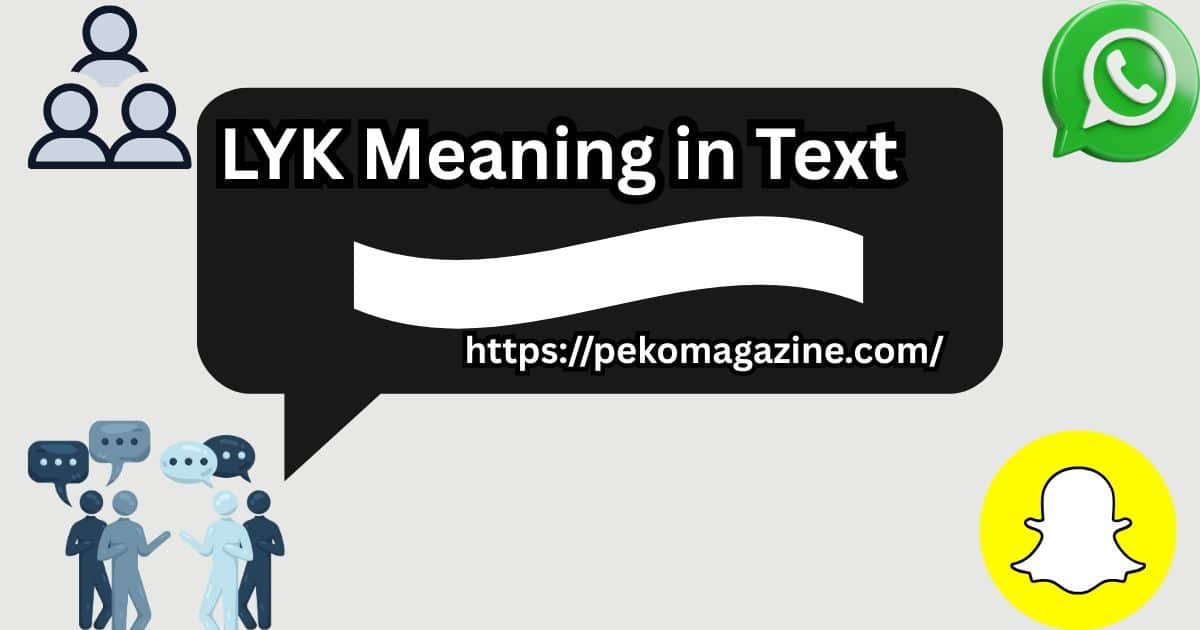Ever stared at your phone wondering what “LYK” means in that text message? You’re not alone. This tiny three-letter combination has sparked confusion across millions of conversations worldwide.
Whether you’re a parent trying to decode your teenager’s messages or a professional navigating casual workplace chats, understanding LYK meaning in text is essential for modern communication.
Here’s what you’ll discover: the exact definitions, real conversation examples, response strategies, and professional boundaries that’ll make you fluent in this digital shorthand.
What Does LYK Mean? The Core Definition Explained
LYK primarily stands for “Let You Know” in most digital conversations. However, context determines everything. Sometimes lyk means “like” – a casual, trendy spelling that’s gained massive popularity among younger users.
Here’s the breakdown:
| Meaning | Usage Context | Example |
|---|---|---|
| Let You Know | Future promises, updates | “I’ll lyk when I get there” |
| Like | Opinions, comparisons | “That’s lyk so cool!” |
The key lies in sentence structure. When someone says they’ll “LYK tomorrow,” they’re clearly using the “Let You Know” definition. But “That movie was lyk amazing” obviously means “like.”
Quick Recognition Test
Can you replace LYK with “let you know” and maintain proper grammar? If yes, that’s your answer. If the sentence breaks, they’re using it as “like.”
Real-World LYK Usage: Authentic Examples from Daily Life
Understanding lyk meaning in whatsapp and other platforms requires seeing actual conversations. Let’s dive into real scenarios where LYK appears naturally.
Friend Coordination Scenarios
Sarah: “Movie tonight at 7?”
Alex: “Maybe! I’ll lyk by 5 PM”
Sarah: “Cool, need headcount for tickets”
Here, lyk in chat clearly means “let you know” – Alex is promising future information.
Social Media Interactions
Instagram Comment: “Your outfit is lyk perfect for this weather! 😍”
In social media contexts, LYK often appears as the trendy “like” spelling, especially among Gen Z users who enjoy linguistic creativity.
Gaming Community Usage
Discord Chat:
Player1: “Raid starting soon?”
Player2: “lyk 10 minutes, still gathering team”
Gaming communities frequently use lyk full form in chat as “like” for quick approximations and casual expressions.
Dating App Conversations
Match 1: “That restaurant looks amazing!”
Match 2: “Right? I’ll lyk if I can get reservations”
Dating contexts typically favor the “let you know” interpretation, as people make plans and coordinate activities.
Platform-Specific LYK Usage Patterns
Different platforms have developed distinct LYK cultures. Understanding these nuances prevents miscommunication across digital spaces.
Instagram DMs vs WhatsApp
Instagram: Tends toward “like” usage
- “Your story was lyk so funny!”
- Creative spelling fits Instagram’s visual, trendy culture
WhatsApp: Leans toward “let you know”
- “I’ll lyk what time I finish work”
- More practical, information-focused conversations
Discord Gaming Culture
Gaming communities have embraced both meanings simultaneously:
- Approximations: “lyk 5 more minutes” (like)
- Updates: “I’ll lyk when servers are up” (let you know)
TikTok Comments
TikTok heavily favors the “like” interpretation:
- “This tutorial is lyk exactly what I needed!”
- “She’s lyk the best dancer ever”
The platform’s young demographic drives this trendy spelling preference.
Context Decoder: Mastering LYK Interpretation
Becoming fluent in LYK meaning in text requires understanding contextual clues that reveal intended meaning.
“Let You Know” Indicators
Future Tense Markers:
- “I’ll lyk tomorrow”
- “Will lyk soon”
- “Gonna lyk later”
Information Promise Phrases:
- “Let me check and lyk”
- “I’ll lyk the details”
- “Can lyk by Friday”
Question Responses:
- “When?” → “I’ll lyk”
- “What time?” → “Will lyk shortly”
“Like” Usage Signals
Comparison Context:
- “It’s lyk a movie!”
- “Tastes lyk chocolate”
- “Looks lyk rain”
Opinion Expression:
- “That’s lyk so cool”
- “He’s lyk really nice”
- “This is lyk perfect”
Approximate Numbers:
- “lyk 20 people came”
- “Waited lyk forever”
- “Cost lyk $50”
See Also: JP Meaning in Text: The Complete 2025 Guide to Understanding This Popular Abbreviation
Smart Response Strategies for LYK Messages
Knowing how to respond appropriately shows digital fluency and prevents awkward misunderstandings.
Responding to “Let You Know” Messages
Acknowledge the Promise:
- “Sounds good, thanks!”
- “No rush, whenever works”
- “Perfect, I’ll wait to hear”
Set Expectations:
- “Any idea when you’ll know?”
- “Need answer by tomorrow if possible”
- “Just checking – still waiting to hear”
Responding to “Like” Usage
Match Their Energy:
- “lyk totally agree!”
- “That’s lyk so true”
- “I know right?”
Standard Responses:
- “Exactly!”
- “I agree”
- “Same here”
When Clarification Needed
Sometimes context remains unclear. Here’s how to ask without seeming clueless:
Subtle Approach: “Just to confirm – you’ll update me later?”
Direct Approach: “Do you mean you’ll let me know or that it’s like something?”
Casual Approach: “Sorry, not sure what you meant there?”
Common LYK Pitfalls and Misunderstandings
Even experienced texters make these mistakes. Avoiding them keeps your conversations smooth.
Age Gap Confusion
Scenario: Teenager texts parent “It was lyk amazing!”
Parent’s Interpretation: “You’ll let me know it was amazing” (confusion)
Actual Meaning: “It was like amazing” (opinion)
Solution: Consider the sender’s age and typical speech patterns.
Cross-Platform Meaning Shifts
The same person might use LYK differently across platforms:
- Work Slack: “I’ll lyk the meeting time” (let you know)
- Personal Instagram: “Concert was lyk incredible” (like)
Autocorrect Disasters
Phone keyboards sometimes create confusion:
- Typing “like” → autocorrects to “LYK”
- Typing “I’ll let you know” → suggests “I’ll lyk”
Always consider technical possibilities when meaning seems off.
Timing Misinterpretations
Problem: “I’ll lyk soon” sent Friday, no follow-up by Monday
Reality: Person forgot, got busy, or “soon” means different timeframes
Solution: Set specific expectations or gentle reminders.
LYK Alternatives and Creative Variations
Expanding your digital vocabulary beyond LYK shows communication sophistication.
Professional “Let You Know” Alternatives
| Casual | Professional |
|---|---|
| I’ll lyk | I’ll update you |
| Will lyk tomorrow | Will follow up tomorrow |
| Let me lyk | Please keep me informed |
Creative “Like” Variations
- Lyk → trendy spelling
- Lyke → old English style
- Lik → ultra-casual
- L8K → number substitution (rare)
Regional Preference Patterns
US Usage: Heavy on both meanings
UK Usage: More formal alternatives preferred
Australia: “Like” spelling creativity popular
Canada: Mixed patterns following US trends
Generation-Specific Alternatives
Gen Z Favorites:
- “periodt” (emphasis)
- “no cap” (truth)
- “fr” (for real)
Millennial Preferences:
- “tbh” (to be honest)
- “ngl” (not gonna lie)
- “imo” (in my opinion)
Gen X/Boomer Options:
- Full words preferred
- “I’ll let you know”
- “It’s like…”
See Also: PTSO Meaning in Text: Your Complete Guide to This Popular Slang Term
Cultural and Regional LYK Variations
Global English speakers have adapted LYK differently based on cultural communication styles.
UK vs US Usage Differences
United Kingdom:
- More formal digital communication
- LYK appears primarily in very casual contexts
- Traditional spelling often preferred
United States:
- Widespread LYK adoption
- Both meanings equally common
- Creative variations embraced
International English Adaptations
India: Mix of formal and casual, context-dependent
Philippines: Heavy social media LYK usage
Nigeria: Preference for full words in professional settings
South Africa: Regional slang influences LYK interpretation
Social Group Preferences
Students: High LYK usage across all contexts
Professionals: Primarily “let you know” meaning
Gamers: Both meanings, context-dependent
Parents: Learning curve, gradually adopting
Professional LYK Boundaries: When and Where It’s Appropriate
Understanding lyk full form in professional contexts prevents career-damaging communication mistakes.
Workplace Appropriateness Scale
| Setting | LYK Acceptable? | Better Alternative |
|---|---|---|
| CEO Email | ❌ Never | “I will inform you” |
| Team Slack | ✅ Sometimes | “I’ll update the team” |
| Colleague Text | ✅ Usually fine | Context-dependent |
| Client Communication | ❌ Avoid | “I will follow up” |
Industry-Specific Guidelines
Tech Companies:
- Casual digital communication accepted
- LYK common in internal chats
- Client communications remain formal
Finance/Banking:
- Conservative communication expected
- LYK inappropriate in most contexts
- Formal language maintains professionalism
Creative Industries:
- Relaxed communication styles
- LYK reflects industry culture
- Client relationships determine formality
Healthcare:
- Clear communication critical
- Abbreviations avoided for safety
- Professional standards maintained
Email vs Slack Usage Rules
Email Guidelines:
- Avoid LYK with external contacts
- Internal emails: proceed with caution
- When uncertain, choose formal alternatives
Slack/Teams Protocol:
- Team culture determines acceptability
- Direct messages: usually acceptable
- Channel posts: consider audience
See Also: FN Meaning in Text: Complete Guide to Understanding This Popular Acronym
Comprehensive FAQ Solutions
Is LYK Rude or Dismissive?
Not inherently. Context and relationship determine perception. “I’ll lyk later” between friends shows casual comfort. The same phrase to your boss might seem unprofessional rather than rude.
Can Older Adults Use LYK Naturally?
Absolutely! Many 40+ adults successfully incorporate LYK into casual digital conversations. The key is starting with family or close friends before expanding usage.
Gaming-Specific LYK Meanings
Gaming communities have developed unique LYK applications:
- Time estimates: “lyk 5 minutes”
- Approximations: “lyk 30 people online”
- Updates: “I’ll lyk when ready”
Teaching LYK to Parents/Grandparents
Step-by-Step Approach:
- Explain both meanings clearly
- Show real conversation examples
- Practice in low-stakes conversations
- Encourage questions without judgment
- Celebrate successful usage
Common Senior Concerns:
- “Will people think I’m trying too hard?” (Usually no)
- “Is it grammatically correct?” (Digital communication has different rules)
- “Should I use it with everyone?” (Start with family)
Future-Proof Your LYK Knowledge
Digital language evolves rapidly. Understanding LYK meaning in text today positions you for tomorrow’s communication trends.
LYK Evolution Predictions
Short-Term Trends (1-2 years):
- Increased professional acceptance
- Platform-specific meaning solidification
- Voice-to-text integration improvements
Long-Term Changes (3-5 years):
- Potential new meanings emergence
- Geographic usage pattern shifts
- Integration into formal dictionaries
Staying Current with Digital Slang
Monthly Habit: Check urban dictionary updates
Weekly Practice: Notice new usage patterns in your conversations
Daily Awareness: Pay attention to context clues in incoming messages
Master LYK Usage Today: Your Action Plan
You now possess comprehensive LYK meaning in text knowledge. Here’s your immediate implementation strategy:
This Week:
- Practice identifying LYK meanings in your current conversations
- Experiment with appropriate responses
- Notice platform-specific usage patterns
This Month:
- Gradually incorporate LYK into casual conversations
- Test professional boundary understanding
- Help others learn through patient explanation
Ongoing:
- Stay alert to evolving meanings
- Maintain context awareness
- Balance trendy usage with clear communication
Remember: Effective digital communication combines current knowledge with timeless principles of clarity, respect, and audience awareness. LYK is just one tool in your modern communication toolkit.
Whether lyk means “let you know” or “like” in your next conversation, you’re ready. The confidence that comes from true understanding transforms every digital interaction from potential confusion into smooth, natural communication.
Start applying this knowledge today. Your conversations will never be the same.

